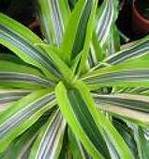WHY ARE HOUSEPLANTS BENEFICIAL?
Aesthetic Value
Aesthetic Value
- They are a natural way to beautify any indoor space. House plants brighten up rooms, kitchens and even bathrooms. Blooming house plants--add color and brighten up even the drabbest of spaces.
- According to "All You Need to Know About Gardening But Were Afraid to Ask," house plants improve indoor air quality. They clear the air of harmful carbon dioxide and release vital oxygen by photosynthesis.
*NASA discovered that house plants remove other airborne toxins---including formaldehyde, carbon monoxide, chloroform, benzene, xylene and ammonia---which are emitted by electrical appliances and synthetic, man-made materials, including plastic floor and wall coverings, chipboards, ceiling tiles and carpets. These indoor pollutants adversely affect health and cause a range of symptoms, such as fatigue, headaches, allergies and even fatal nervous-system disorders.
- According to "Save the Planet: 52 Brilliant Ideas for Rescuing Our World," house plants have a positive psychological effect on humans. Marjolein Elings (from the Wageningen University and Research Center in the Netherlands) conducted research on the role of plants in human lives. Her findings are published in the book "Farming for Health." According to Elings, plants and an active interaction with plants improve health, self-esteem, concentration, pride and sense of accomplishment. Plants enhance the sense of enjoyment, tranquility, autonomy and relaxation.

Passing on 'Love of Gardening' ...
I absolutely love gardening and, for me, there's no bigger joy than passing this passion on to my children. When my oldest son was 13, he asked if he could have a cactus for his room. He cared for that cactus plant and, as years went by, continued to add other varieties to his collection. Some thrived, some failed but he never gave up. My son is now married with his own beautiful gardens that he digs in, mulches, plants and continues to create. He truly has grown to love gardening.
I share this story because I just brought home a cactus, to my youngest son, this week. His response truly surprised me, especially, when I saw him pick and the cactus and say to his Dad, "Wow, look Mom brought me a cactus!" He proceeded to ask "Where are we going to put it?" When I answered "You can keep it in your room and take care of it", he gave me the biggest smile. That smile touched my heart. My hope is that his love of a single 'plant gift' will be the beginning of a lifetime of loving gardening, digging into the soil and creating gardens of his own.
With a Warm Heart, "Happy Gardening" .... Susan
I absolutely love gardening and, for me, there's no bigger joy than passing this passion on to my children. When my oldest son was 13, he asked if he could have a cactus for his room. He cared for that cactus plant and, as years went by, continued to add other varieties to his collection. Some thrived, some failed but he never gave up. My son is now married with his own beautiful gardens that he digs in, mulches, plants and continues to create. He truly has grown to love gardening.
I share this story because I just brought home a cactus, to my youngest son, this week. His response truly surprised me, especially, when I saw him pick and the cactus and say to his Dad, "Wow, look Mom brought me a cactus!" He proceeded to ask "Where are we going to put it?" When I answered "You can keep it in your room and take care of it", he gave me the biggest smile. That smile touched my heart. My hope is that his love of a single 'plant gift' will be the beginning of a lifetime of loving gardening, digging into the soil and creating gardens of his own.
With a Warm Heart, "Happy Gardening" .... Susan
Proudly powered by Weebly





